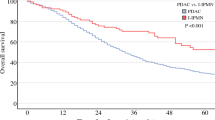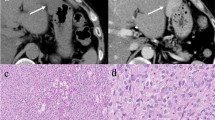Abstract. Radiologically demonstrable pancreatic endocrine tumors are a frequent requirement for exploration in patients with multiple endocrine neoplasia type I (MEN-I). Such delayed intervention is accompanied by a 30% to 50% incidence of pancreatic endocrine metastases. This study explores biochemical tumor markers and operative findings in relation to preoperative pancreatic radiology in 25 MEN-I patients. They underwent pancreatic surgery with (
n = 19) or without ( n = 6) radiologic signs of primary tumor and absence of metastases upon conventional examination, including OctreoScan testing ( n = 10). Biochemical diagnosis required an increasing elevation of at least two independent pancreatic tumor markers. Tumor diameters averaged 1.1 cm (0–5 cm) and 0.9 cm (0.2–1.5 cm) in the patients with and without positive preoperative radiology, respectively. These investigations never displayed more than one of the consistently multiple tumors, and the results were falsely positive in 26%. Preoperatively unidentified regional or hepatic metastases were found at surgical exploration in 26% of patients with radiologic localization and in none of the others. Limited pancreatic tumor involvement necessitated intraoperative absence of metastases and pancreatic lesions ≤ 1 cm in diameter on palpation, intraoperative ultrasonography, and microscopy. It occurred in 37% and 50% of the patients with and without radiologic tumor localization, respectively. The number of positive tumor markers was similar for patients with limited and major disease (2.3 vs. 2.7), whereas four or more such markers were found in all those with malignancies. The mean marker level was higher in patients with radiologically demonstrable tumors and lower in those with limited disease, but with a substantial overlap. OctreoScan testing was negative in all cases with limited disease and was the single most sensitive method (75%) in the others. Limited pancreatic disease could not be identified preoperatively, and the present means of biochemical pancreatic tumor identification invariably involved the presence of at least one lesion ≥ 7 mm in diameter. Conventional pancreatic imaging is insensitive and nonspecific for recognizing even substantial pancreatic tumors associated with MEN-I.
Similar content being viewed by others
Author information
Authors and Affiliations
Rights and permissions
About this article
Cite this article
Skogseid, B., Öberg, K., Åkerström, G. et al. Limited Tumor Involvement Found at Multiple Endocrine Neoplasia Type I Pancreatic Exploration: Can It Be Predicted by Preoperative Tumor Localization?. World J. Surg. 22, 673–678 (1998). https://doi.org/10.1007/s002689900451
Issue Date:
DOI: https://doi.org/10.1007/s002689900451




